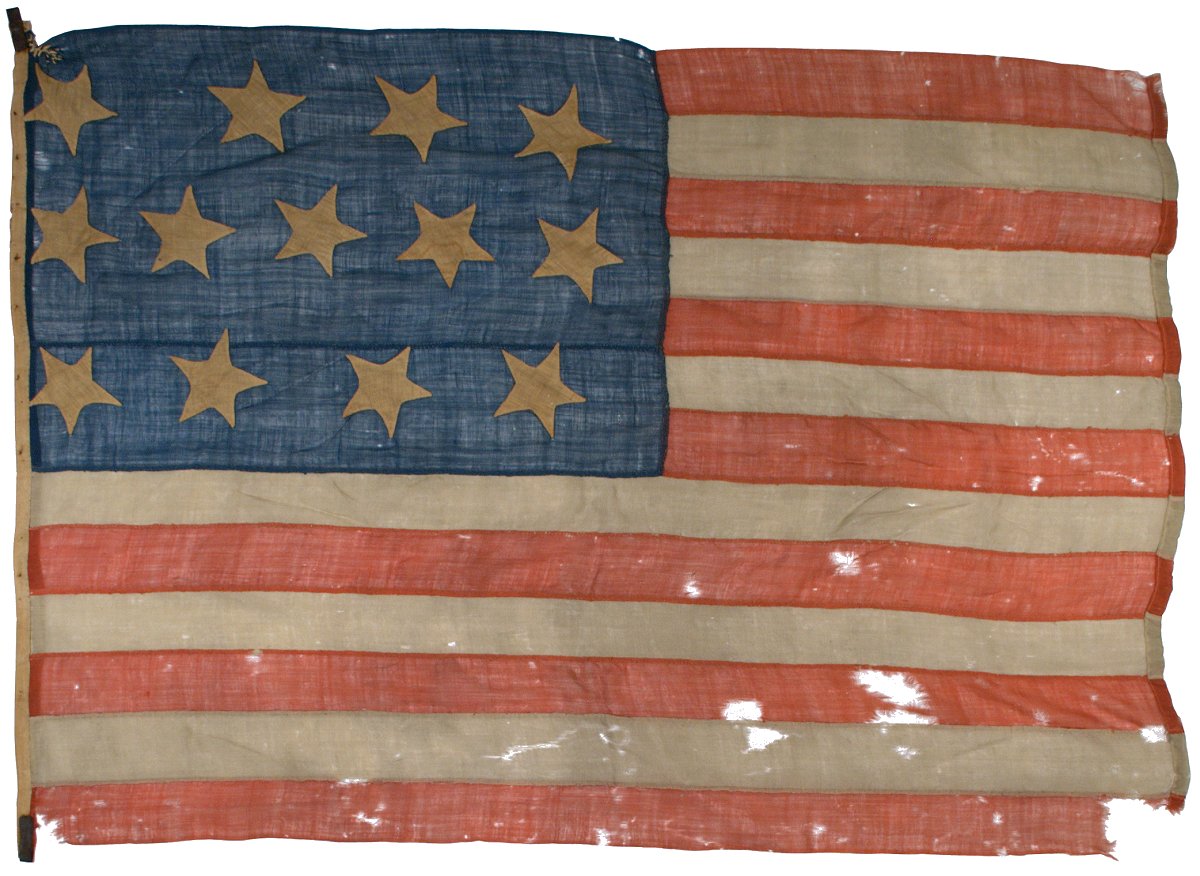 This
rare flag of 13 stars dates to the period circa
1820-1840. It has several traits in
both its materials and construction techniques that
are characteristic of flags from this time period or
perhaps even as early as 1810, when compared with
other examples.
The use of the 4-5-4 pattern on 13 star flags dates back
to the 18th century. Thirteen star flags have been
in continual use in America and were used by the Navy
throughout the 19th and into the 20th century.
By the time of the Civil War, the 3-2-3-2-3 pattern
became prevalent, but in the pre-Civil War era, the
4-5-4 pattern was more often used. The style of the
stars, which are unevenly spaced and freely rotating,
is also indicative of a pre-Civil War flag. The wool
bunting of the flag is wispy, light-weight weave seen on
early 19th century flags, and the cotton used for the
stars is also loosely woven. Among the flags in the Rare
Flags collection, this flag's cotton and wool bunting,
including its lighter blue canton, is most like
IAS-00319, a 24 star flag updated to 25 stars
(1821-1836) which is why I attribute the flag to this
earlier period. The stars of the flag are
double-appliqué, rather than single-appliqué. Many flags of the very early
19th century have single-appliqué stars, by the mid-19th
century, double-appliqué stars as see on his flag became
more prevalent. The thread
used to sew the stars is cotton, but the stripes are
sewn using a waxed linen thread often used for maritime
flags due to its ability to withstand the elements.
It's unclear when the leather reinforcements were added
to the cotton hoist, and it is not common on early flags
but makes good sense, since the grommets of early flags
were whip-stitched and made of stitching and the hoist
fabric itself, and tended to tear through after
prolonged use. This
rare flag of 13 stars dates to the period circa
1820-1840. It has several traits in
both its materials and construction techniques that
are characteristic of flags from this time period or
perhaps even as early as 1810, when compared with
other examples.
The use of the 4-5-4 pattern on 13 star flags dates back
to the 18th century. Thirteen star flags have been
in continual use in America and were used by the Navy
throughout the 19th and into the 20th century.
By the time of the Civil War, the 3-2-3-2-3 pattern
became prevalent, but in the pre-Civil War era, the
4-5-4 pattern was more often used. The style of the
stars, which are unevenly spaced and freely rotating,
is also indicative of a pre-Civil War flag. The wool
bunting of the flag is wispy, light-weight weave seen on
early 19th century flags, and the cotton used for the
stars is also loosely woven. Among the flags in the Rare
Flags collection, this flag's cotton and wool bunting,
including its lighter blue canton, is most like
IAS-00319, a 24 star flag updated to 25 stars
(1821-1836) which is why I attribute the flag to this
earlier period. The stars of the flag are
double-appliqué, rather than single-appliqué. Many flags of the very early
19th century have single-appliqué stars, by the mid-19th
century, double-appliqué stars as see on his flag became
more prevalent. The thread
used to sew the stars is cotton, but the stripes are
sewn using a waxed linen thread often used for maritime
flags due to its ability to withstand the elements.
It's unclear when the leather reinforcements were added
to the cotton hoist, and it is not common on early flags
but makes good sense, since the grommets of early flags
were whip-stitched and made of stitching and the hoist
fabric itself, and tended to tear through after
prolonged use.
Though the entire flag was
originally hand-stitched, there is one run of
machine stitching along the fly end where the edge of
the stripes was doubled back and re-hemmed. The
machine stitching is a chain stitch, which is the type
produced by earliest sewing machine introduced to the
United States in the late 1850's. This kind of repair
is not uncommon on early flags, and would have been done
to this flag circa 1855-1860. This is reasonable
evidence that the flag was still in use in late 1850's.
Since this is a repair, and not the primary means of
construction, the presence of this machine stitching
does not represent a "no earlier than" date for the
flag, but rather a "was still in use as late as" date.
I do believe the flag is earlier, and of the 1820-1840
period for its time of manufacture, based on comparisons with
other known flags such as the 20-star (IAS-00255),
24-star (IAS-00319),
and 28-star (IAS-00293),
and 30-star (IAS-00298)
and 31-star (IAS-00106).
This same type of stitching is seen the 31-star
(IAS-00106) flag dating to the period of
California statehood, circa 1851-1858, but in the case
of that flag, the chain stitching is the primary sewing
means used on the stripes of the flag itself, rather
than just for a repair. The canton is
wider than the top seven stripes, which is evidence that
the flag was shortened considerably from its original
width due to wind damage on its fly end. Overall,
the flag is a very beautiful and rare example of an
early 13 star flag dating to early 19th century. |

